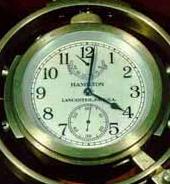The Chronometer
 |
The chronometer is a timepiece with a nearly
constant rate. It is used for making accurate estimations of the correct
time in the absence of time reference signals as available from radio broadcast
services or satellite systems.
Time on board of a ship is important for example to:
- determine speed with a traditional log,
- plan observations for celestial navigation,
- determine longitude by methods of celestial navigation,
- plan recordings or captures of radio transmissions (e.g. weather forecasts)
The determination of position by Celestial
Navigation methods requires correct (absolute) time information down to the
second. Roughly an error of 4 seconds corresponds to a position error of
1 nautical mile.
|
Absolute time was introduced into marine
navigation not before the 17th century, when John Harrison (1693-1776) made
the first accurate and portable clocks, which enabled determination of position
by methods of Celestial Navigation. The chronometer on board, would kept
track of the time in England, and by comparing this with local time, a navigator
could find the longitude of his ship. Solving this "longitude problem" produced
a revolution in European exploration and mapping.
Before, it was impossible to determine the
exact longitude of an unknown location and "time" on board of a ship was
only used to determine speed and travelled distance used for dead reckoning
navigation. Time intervals were measured with a sandglass.
Also board time was "measured" by timing fixed time intervals
with a sandglass.
|
 |
Today, at least one accurate chronometer will be
on board of each offshore sailing vessel. The chronometer is normally maintained
to UTC time and used as reference clock for other on-board clocks. The board
clock will show local time, but it is synchronized with the UTC chronometer
at regular intervals.
For taking altitudes of celestial bodies, a separate
stop-watch is used, started at a known chronometer time. The elapsed time
of each sight is added to this chronometer starting time to obtain the UTC
time of the sight.
Chronometer Error and Chronometer Correction
The chronometer error is the amount of
time by which the chronometer time differs from the correct time to which
it was set, usually UTC (Universal Time Coordinated). The chronometer error
is expressed to an accuracy of one second and has an algebraic sign according
to:
chronometer-error = chronometer-time - correct-time
The chronometer correction is the amount
that must be added algebraically to the chronometer time to obtain the correct
time. It is numerically equal to the chronometer error, but of opposite sign:
chronometer-time + chronometer-correction = correct-time
The chronometer is checked at regular intervals
with an accurate time signal as obtainable from satellite or radio signals.
These checks should be recorded in a table similar to the one shown below
and stored with the chronometer. With this record it is possible to make
accurate estimations for times after the last chronometer check.
| Date |
UTC |
Chrono.
time |
Chrono.
Correction |
Chrono.
Rate |
| ... |
... |
... |
... |
... |
| 31-Oct-2001 |
07:00:00 |
06:59:27 |
+00:00:33 |
+0.0473 |
| 21-Nov-2001 |
12:00:00 |
11:59:26 |
+00:00:34 |
+0.0455 |
| 13-Jan-2002 |
13:45:00 |
13:44:23 |
+00:00:37 |
+0.0566 |
| 25-Feb-2002 |
20:00:00 |
19:59:21 |
+00:00:39 |
+0.0465 |
| |
|
|
|
|
|
|
The chronometer rate is the amount
of time lost or gained by a chronometer in a unit of time. It is usually
expressed in seconds per day, to an accuracy of 0.001second.
The chronometer rate should be recorded with the correct sign, according to the
changing of the chronometer correction:
positive if the chronometer correction is increasing; negative when the chronometer
correction is decreasing.
|
From the chronometer rate and the last recorded chronometer correction, the
correct time for a current instance may be calculated:
correct-time = chronometer-time + chronometer-correction + chronometer-rate * number-of-days
where "number-of-days" is the number of elapsed days since the last recorded
chronometer correction.
The spring-driven ship clocks constructed by John
Harrison in the 17th century had a rate of about 0.750s/day. Modern electrical
quartz-crystal-based chronometers may have a rate better than 0.010s/day.
In this case the rate should nevertheless be recorded with the appropriate
precision, and checked for unexpected changes, which may indicate a deterioration
of battery capacity or some other need for service.
|

